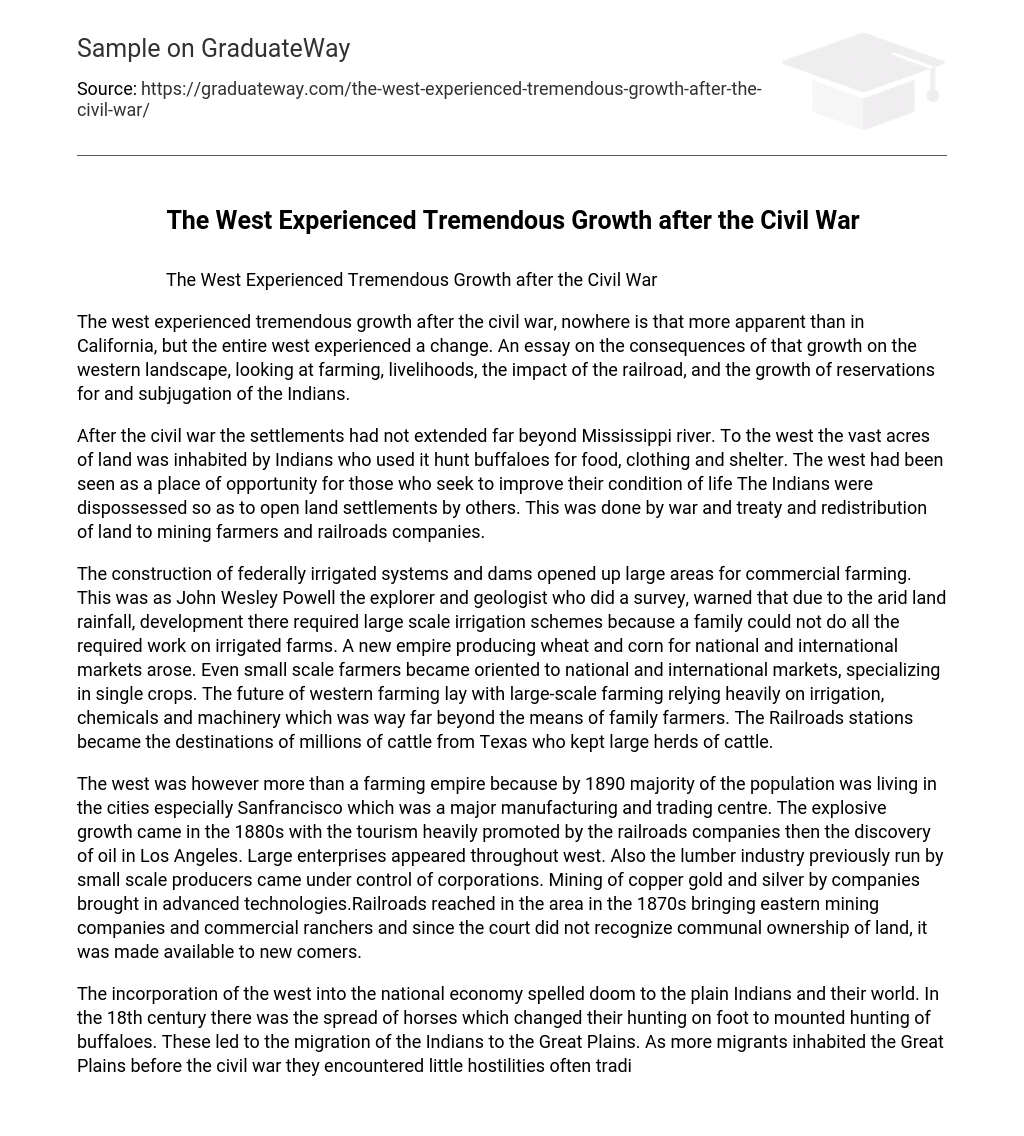The west experienced tremendous growth after the civil war, nowhere is that more apparent than in California, but the entire west experienced a change. An essay on the consequences of that growth on the western landscape, looking at farming, livelihoods, the impact of the railroad, and the growth of reservations for and subjugation of the Indians.
After the civil war the settlements had not extended far beyond Mississippi river. To the west the vast acres of land was inhabited by Indians who used it hunt buffaloes for food, clothing and shelter. The west had been seen as a place of opportunity for those who seek to improve their condition of life The Indians were dispossessed so as to open land settlements by others. This was done by war and treaty and redistribution of land to mining farmers and railroads companies.
The construction of federally irrigated systems and dams opened up large areas for commercial farming. This was as John Wesley Powell the explorer and geologist who did a survey, warned that due to the arid land rainfall, development there required large scale irrigation schemes because a family could not do all the required work on irrigated farms. A new empire producing wheat and corn for national and international markets arose. Even small scale farmers became oriented to national and international markets, specializing in single crops. The future of western farming lay with large-scale farming relying heavily on irrigation, chemicals and machinery which was way far beyond the means of family farmers. The Railroads stations became the destinations of millions of cattle from Texas who kept large herds of cattle.
The west was however more than a farming empire because by 1890 majority of the population was living in the cities especially Sanfrancisco which was a major manufacturing and trading centre. The explosive growth came in the 1880s with the tourism heavily promoted by the railroads companies then the discovery of oil in Los Angeles. Large enterprises appeared throughout west. Also the lumber industry previously run by small scale producers came under control of corporations. Mining of copper gold and silver by companies brought in advanced technologies.Railroads reached in the area in the 1870s bringing eastern mining companies and commercial ranchers and since the court did not recognize communal ownership of land, it was made available to new comers.
The incorporation of the west into the national economy spelled doom to the plain Indians and their world. In the 18th century there was the spread of horses which changed their hunting on foot to mounted hunting of buffaloes. These led to the migration of the Indians to the Great Plains. As more migrants inhabited the Great Plains before the civil war they encountered little hostilities often trading with food and supplies. But as settlers encroached on their land, conflicts between the armies and the plain tribes began in the 1850s and continued. They had killed hundreds of white settlers before being subdued by the army. They were then forced to cede much of their land to the government and give some land to their former slaves. Civil wars generals like Philip H. Sheridan set out to destroy the Indian economy-villages, horses and buffaloes by rendering the buffaloes extinct. The Indians were then put in reservations. Many laws and treaties offered the native Indians a right to become American citizens if they abandoned their tribal setting and assimilate into American society of which most did not up to until 1924 when the congress made all Indians American citizens.
The growth in the west was characterized by many factors. Large-scale farming however plays the biggest role in opening up the region .Also the railroads companies brought in tourism ,ranchers and also miners who used advanced technologies creating employment to the immigrants and also boosting the west economically. The Native Americans however became the losers of the growth as they were forced to cede most of their land to the government and also forced to live in reservations.
Works Cited:
Funer, Eric. Give me liberty! An American History, 2nd ed.
January 2nd 2009 <http://www.wwnorton.com/gateway/entry.asp?site=foner2v2_ebook> 591-614.





